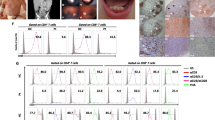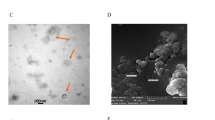Abstract
The normal thymus contributes to T lymphocytes differentiation and induction of tolerance to self-antigens. Myasthenia gravis (MG) is characterized by abnormal thymic hyperplasia. To assess the potential influence of MG-thymus on the differentiation of T lymphocytes differentiation, we used the MG-thymus transplanted severe combined immunodeficiency (SCID) mice model to evaluate the human cord blood stem cells differentiation. Thymus fragments from MG patient and human cord blood stem cells were transplanted into SCID mice successively. SCID mice were observed to develop sustained human T lymphocytes and a functional anti-tumor immune. The levels of various T cell subsets in SCID mice with MG-thymus were different from that of control group. Among that, the frequency of CD4+CD25+ T cells was significant lower in SCID mice with MG-thymus. The deficiency of CD4+CD25+ T cells seens to contribute to the pathogenesis of MG.




Similar content being viewed by others
References
Vincent A, Palace J, Hilton-Jones D (2001) Myasthenia gravis. Lancet 357:2122–2128
Molnar J, Szobor A (1990) Myasthenia gravis: effect of thymectomy in 425 patients, a 15-year experience. Eur J Cardiothorac Surg 4:8–14
Cabarrocas J, Cassan C, Magnusson F, Piaggio E, Mars L, Derbinski J, Kyewski B, Gross DA, Salomon BL, Khazaie K, Saoudi A, Liblau RS (2006) Foxp3+ CD25+ regulatory T cells specific for a neo-self-antigen develop at the double-positive thymic stage. Proc Natl Acad Sci USA 103:8453–8458
Utsugisawa K, Nagane Y, Suzuki S, Kondoh R (2007) Antigen-specific T-cell activation in hyperplastic thymus in myasthenia gravis. Muscle Nerve 36:100–103
Flores KG, Li J, Sempowski GD, Haynes BF, Hale LP (1999) Analysis of the human thymic perivascular space during aging. J Clin Invest 104:1031–1039
Mosier DE, Gulizia RJ, Baird SM, Wilson DB (1988) Transfer of a functional human immune system to mice with severe combined immunodeficiency. Nature 335(6187):256–259
Lieber MR, Hesse JE, Lewis S, Bosma GC, Rosenberg N, Mizuuchi K, Bosma MJ, Gellert M (1988) The defect in murine severe combined immune deficiency: joining of signal sequences but not coding segments in V(D)J recombination. Cell 55(1):7–16
Schönbeck S, Padberg F, Marx A, Hohlfeld R, Wekerle H (1993) Transplantation of myasthenia gravis thymus to SCID mice. Ann NY Acad Sci 681:66–73
Spuler S, Marx A, Kirchner T, Hohlfeld R, Wekerle H (1994) Myogenesis in thymic transplants in the severe combined immunodeficient mouse model of myasthenia gravis. Differentiation of thymic myoid cells into striated muscle cells. Am J Pathol 145(4):766–770
Meinl E, Klinkert WE, Wekerle H (1991) The thymus in myasthenia gravis. Changes typical for the human disease are absent in experimental autoimmune myasthenia gravis of the Lewis rat. Am J Pathol 139(5):995–1008
Lapidot T, Pflumio F, Doedens M, Murdoch B, Williams DE, Dick JE (1992) Cytokine stimulation of multilineage hematopoiesis from immature human cells engrafted in SCID mice. Science 255:1137–1141
McCune JM, Namikawa R, Kaneshima H, Shultz LD, Lieberman M, Weissman IL (1988) The SCID-hu mouse: murine model for the analysis of human hematolymphoid differentiation and function. Science 241:1632–1639
Lan P, Tonomura N, Shimizu A, Wang S, Yang YG (2006) Reconstitution of a functional human immune system in immunodeficient mice through combined human fetal thymus/liver and CD34+ cell transplantation. Blood 208:487–492
Sakaguchi S, Sakaguchi N, Asana M, Itoh M, Toda M (1995) Immunologic self-tolerance maintained by activated T cells expressing IL-2 receptor alpha-chain(CD25), Breakdown of a single mechanism of self-tolerance causes various autoimmune diseases. J Immunol 155:1151–1164
Baecher-Allan C, Hafler DA (2004) Suppressor T cells in human diseases. J Exp Med 200:273–276
Balandina A, Lécart S, Dartevelle P, Saoudi A, Berrih-Aknin S (2005) Functional defect of regulatory CD4+CD25+ T cells in the thymus of patients with autoimmune myasthenia gravis. Blood 105:735–741
Acknowledgments
This work is supported by the project of National Natural Science Foundation of China. Project number: 81172874.
Conflict of interest
The authors declare that they have no conflict of interest.
Author information
Authors and Affiliations
Corresponding author
Additional information
Q. R. Li and P. P. Liu contributed equally to this work.
Rights and permissions
About this article
Cite this article
Li, Q.R., Liu, P.P., Xuan, X.Y. et al. Influence of human myasthenia gravis thymus on the differentiation of human cord blood stem cells in SCID mice. Neurol Sci 35, 191–197 (2014). https://doi.org/10.1007/s10072-013-1476-8
Received:
Accepted:
Published:
Issue Date:
DOI: https://doi.org/10.1007/s10072-013-1476-8




